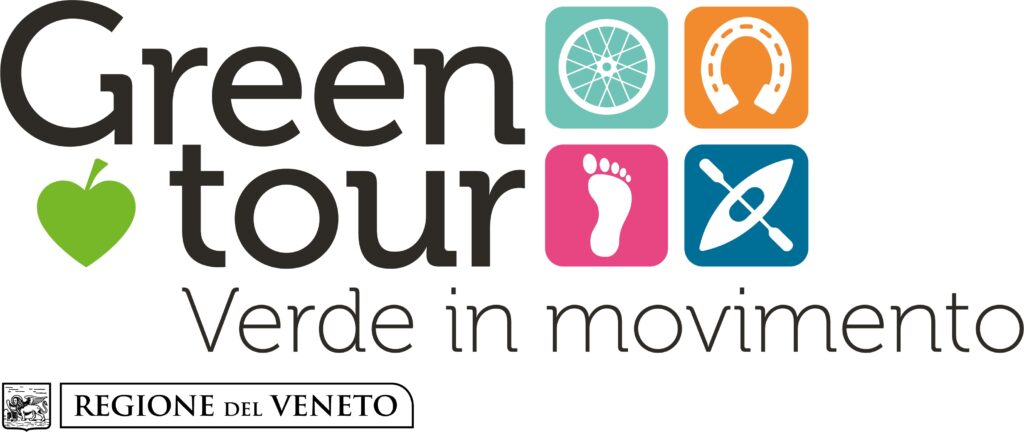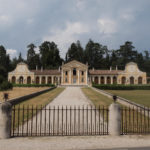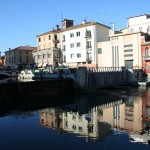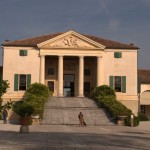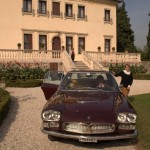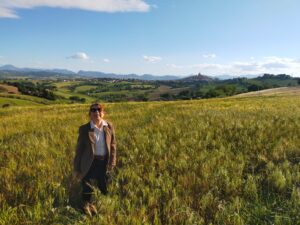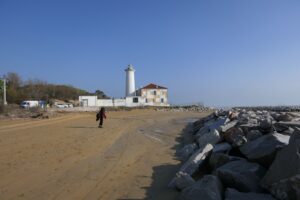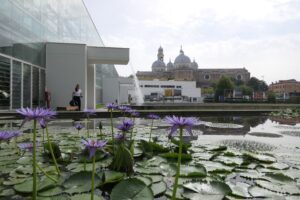Historical & architectural treasures in the North Eastern Italy
Veneto Green Tour
A circular cycling route in 7 stages
Here is a tourist itinerary for discovering the Veneto region at a leisurely pace, exploring nature, culture, gastronomy, and traditions. It’s a 330 km cycling route with 7 stages, designed to be completed in 5/7 or more days. You can start from the north in Treviso, east from Venice, south from Padua, or west from Vicenza. Each stage, with an average duration of 3 or 4 hours (depending on your legs!), provides an opportunity to stop and explore the surroundings. For example, you can follow the recommendations we offer in our Italia Slow Tour videos!
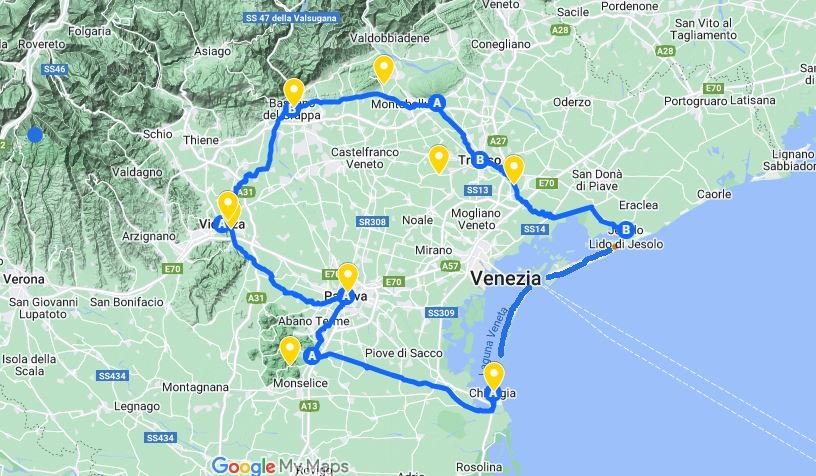
Step 1st
GT 1– SILE
Technical data:
- Distance: 52.4 km
- Minimum elevation: -12 m
- Maximum elevation: 21 m
- Cumulative ascent: 28 m
- Cumulative descent: 39 m
The Green Tour stage that travels along the Sile River from Treviso to Jesolo passes through quaint villages, historic boat cemetery, and green bends. It’s a series of expansive views that pass by Pontboset, Casier, Lughignano, and Casale sul Sile until reaching Musestre di Roncade. You can also load the bike onto the train in Quarto d’Altino to get to Venice. The path continues to the sea, where it ends in Jesolo. There are a few worthwhile side trips that could be taken, such as to Altino, an ancient Roman city well-known for its archaeological remains, or to Musile di Piave. You might choose to travel on from Jesolo to all the other well-known Adriatic beach towns, such as Caorle, Bibione, and Lignano.
Italia Slow Tour advice: Park your bike in Treviso and enjoy a boat ride on the Sile River. The entire city is encircled by a ferryable canal! A unique sightseeing tour offers you a new viewpoint as you travel through the city in a serene paradise from the river.
Step 2nd
GT2 – VENETIAN LAGOON
Technical data:
- Distance: 57.2 km
- Minimum elevation: -7 m
- Maximum elevation: 0 m
- Cumulative ascent: 7 m
- Cumulative descent: 0 m
The first section of the Green Tour stage in the Venetian Lagoon follows the Sile River from its source in Vedelago to its mouth on the Cavallino Peninsula. The second section uses internal navigation to navigate the Venetian Lagoon’s islands from Jesolo to Chioggia. The journey begins in Jesolo and travels along the Sile to Cavallino before continuing on to Lido and Pellestrina. The last stop is Chioggia, sometimes known as “Little Venice,” where you may take a break to explore the town and the Sottomarina coast. Alternatives could be cycling the Via del Mare, visiting the lagoon islands from Cavallino, or even making your way to Venice.
Italia Slow Tour advice: Visit Chioggia to see the oldest operational mediaeval clock in the world, the Tower of Sant’Andrea clock. It is thought to have been created in 1300 and is credited to Dondi. The Tower is a vertical museum with a different subject on each floor that leads to a lookout at the top with a stunning view of the city.
Step 3rd
RV 13 – FROM THE ADRIATIC TO THE EUGANEAN HILLS
Technical data:
- Distance: 51.0 km
- Minimum Altitude: -3 m
- Maximum Altitude: 14 m
- Cumulative Ascent: 29 m
- Cumulative Descent: 18 m
This stage follows the Bacchiglione River as it begins in Chioggia and Sottomarina and ends at the Adriatic Sea. This level road, which goes by the moniker “La Via del Sale e dello Zucchero” (The Salt and Sugar road), traces the historic river route used by wooden boat carriers to carry goods. After leaving Chioggia’s centre, you bridge the Lusenzo Lagoon, go via Pontelongo and Brondolo, and then follow the Bacchiglione River’s left bank all the way to Battaglia Terme. One can easily access Monselice on one side and Padua on the other by taking the path to the Euganean Hills or the Battaglia Canal.
Italia Slow Tour Advice: Visit the stunning mediaeval village of Arquà Petrarca, one of Italy’s most picturesque villages, for a unique wine and cuisine experience. Don’t miss the chance to sample the local speciality, jujube broth! Jujubes are tiny, rare, ancient fruits that are grown only in families. They are used to make a variety of delicacies, the most well-known of which is a liqueur served at the Enoteca Il Giuggiolo that is specifically named “Brodo di Giuggiole.”
Step 4th
RV 11 – FROM ROVIGO AND PADUA TO THE FOOTHILLS
Technical data:
- Distance: 20.3 km
- Maximum Altitude: 31 m
This stage begins in Rovigo and travels up through the Venetian foothills to Asolo, also known as the “city of a hundred horizons.” The journey follows the Adige River until Anguillara Veneta, where the charming “From the Euganean Hills to the Adige River” itinerary starts. From there, it crosses quiet asphalt roads all the way to Monselice. By travelling the “Path of Saint Anthony,” you arrive at Padua via the Battaglia canal. From there, you proceed to Castelfranco Veneto via the Muson dei Sassi, and ultimately, you travel the “Path of the Ezzelini” to Asolo. For a sweeping view of the surroundings, it’s worthwhile to visit the Fortress and the Castle of Queen Caterina.
Italia Slow Tour Advice: The Scrovegni Chapel, one of the treasures of Italian art created by Giotto at the start of the 14th century, is necessarily the starting point for the discovery of Padua. After more than 700 years of history, the original colours have been kept by recent restorations, giving the impression that the painting was created yesterday.
Step 5th
RV 2 – AIDA CYCLE ROUTE IN THE VENETO
Technical data:
- Distance: 44.9 km
- Minimum Altitude: 10 m
- Maximum Altitude: 50 m
- Cumulative Ascent: 71 m
- Cumulative Descent: 107 m
“Alta Italia da Attraversare”, or the AIDA cycle path, is an interesting bike tourism route that winds its way through northern Italy, connecting the Slovenian border beyond Trieste with the French border at Val di Susa. This amazing opportunity to ride through historically and culturally rich areas is made possible by the route that passes through the Upper Po Valley’s main cities. There are six stages in the roughly 300 km long Veneto segment. The stage that links Vicenza and Padua—two artistic cities that “collect” UNESCO World Heritage monuments that are just waiting to be discovered—is the one recommended in this itinerary.
Italia Slow Tour Advice: Above all, to explore Vicenza is to explore Palladio’s creations! This is where you’ll discover the Basilica (so-called because it’s not really a church) and Teatro Olimpico, his final gigantic creation. Palladio was helped to become a prominent architect after arriving in Vicenza in 1520 and beginning his career as an apprentice. He is considered the father of American architecture by the American Congress—just take a peek at the White House!
Italia Slow Tour advice: Speaking of Palladio, make use of this leisurely journey to see some of his Villas, the opulent historical country homes of the Venetian nobility. For instance, Villa Valmarana (also known as “ai nani”) in the province of Vicenza is home to the incredible riches of Tiepolo’s frescoes!
Step 6th
RV 8 – FROM VICENZA TO THE FOOTHILLS
Technical data:
- Distance: 81.7 km
- Minimum altitude: 56 m
- Maximum altitude: 224 m
- Cumulative climb: 401 m
- Cumulative descent: 345 m
The route travels through Vicenza province, taking in stunning scenery and artistic cities. The route mostly follows peaceful side roads after leaving Vicenza. Following Bassano del Grappa and Marostica, where the quaint mediaeval Living Chess Game is reenacted every two years in September, you reach the province of Treviso and go through Asolo and along the Montello to Volpago. Cycling enthusiasts who enjoy a little rising will find the Montello promontory, with its wooded areas and rolling hills, to be a great place for outdoor sports and always provide stunning views. In addition, it is a historical location connected to the Great War. The Ezzelini Trail from Pagnano and the Brenta cycling route in Bassano del Grappa are two potential deviations. The Tradotta cycle route is a lovely dirt lane on the ancient railway that runs between Montebelluna and Bidasio di Nervesa della Battaglia.
Italia Slow Tour advice: Without a doubt, a visit to Bassano del Grappa is worthwhile. Although the historic bridge at Bassano has been damaged numerous times, it has always been rebuilt in accordance with Palladio’s original design. Because the Alpini rebuilt it after it was destroyed in 1948 during World War II, it is also known as the Ponte degli Alpini. If you’re looking for a unique local memento, Bassano is well-known for its grappa, and the old town by the bridge is home to several historic distilleries.
Italia Slow Tour Advice: When it comes to Palladian villas, one of the most notable is Villa Barbaro in Maser, which is recognised as a UNESCO World Heritage site. Huge gardens surround the villa’s exterior, and Paolo Veronese painted murals inside and included a self-portrait for future generations.
Step 7th
RV 15 – FROM TREVISO TO THE FOOTHILLS
Technical data:
- Distance: 17.3 km
- Time: 50 minutes
This stage crosses the Treviso March by riding the Venice-Monaco road, which has complete signage that is appropriate even for inexperienced riders. The route covers a wide range of topics, including the Great War, the Venetian nature of big and small towns, and historical and cultural allusions to the Serenissima. Remember that the Conegliano and Valdobbiadene areas of the Hills of Prosecco are UNESCO World Heritage Sites. Starting in Treviso, the route continues through Villorba, Nervesa della Battaglia, and ends in Conegliano. A suggested diversion takes you to Conegliano’s historic centre, home to the mediaeval Castle and San Lorenzo Cathedral. As it proceeds in the direction of Vittorio Veneto, it passes through Susegana and joins the Monticano cycling route.It crosses Ceneda, a part of Vittorio Veneto, and ends in the historic center of Serravalle, where you can discover the Cathedral of the Assumption and the Castle of San Martino.
Italia Slow Tour advice: The final significant wetland remaining along the Sile is the Cervara Oasis, which can be found on the Ostiglia-Treviso cycling path. a safe haven where you may experience the history and natural beauty of this river region up close. An excellent chance to park your bike and go for a stroll, go birdwatching, take pictures of the natural world, or participate in some informative courses led by park officials.
